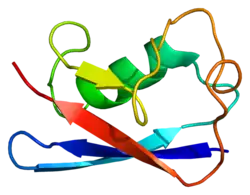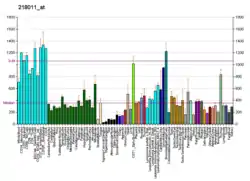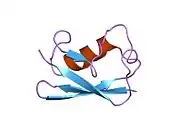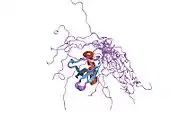UBL5
Ubiquitin-like protein 5 is a protein that in humans is encoded by the UBL5 gene.[5]
| UBL5 | |||||||||||||||||||||||||
|---|---|---|---|---|---|---|---|---|---|---|---|---|---|---|---|---|---|---|---|---|---|---|---|---|---|
 | |||||||||||||||||||||||||
| |||||||||||||||||||||||||
| Identifiers | |||||||||||||||||||||||||
| Aliases | UBL5, HUB1, ubiquitin like 5 | ||||||||||||||||||||||||
| External IDs | OMIM: 606849 MGI: 1913427 HomoloGene: 83305 GeneCards: UBL5 | ||||||||||||||||||||||||
| |||||||||||||||||||||||||
| |||||||||||||||||||||||||
| |||||||||||||||||||||||||
| |||||||||||||||||||||||||
| Orthologs | |||||||||||||||||||||||||
| Species | Human | Mouse | |||||||||||||||||||||||
| Entrez | |||||||||||||||||||||||||
| Ensembl | |||||||||||||||||||||||||
| UniProt | |||||||||||||||||||||||||
| RefSeq (mRNA) | |||||||||||||||||||||||||
| RefSeq (protein) | |||||||||||||||||||||||||
| Location (UCSC) | Chr 19: 9.83 – 9.83 Mb | Chr 9: 20.64 – 20.65 Mb | |||||||||||||||||||||||
| PubMed search | [3] | [4] | |||||||||||||||||||||||
| Wikidata | |||||||||||||||||||||||||
| |||||||||||||||||||||||||
It has been shown that in C. elegans mitochondria treated to lower expression of certain electron transport chain proteins during the L3/L4 stage, its expression levels is higher leading to increased lifespans.[6]
Ubiquitin-like proteins (UBLs) are thought to be reversible modulators of protein function rather than protein degraders like ubiquitin (MIM 191339).[supplied by OMIM][5]
References
- GRCh38: Ensembl release 89: ENSG00000198258 - Ensembl, May 2017
- GRCm38: Ensembl release 89: ENSMUSG00000084786 - Ensembl, May 2017
- "Human PubMed Reference:". National Center for Biotechnology Information, U.S. National Library of Medicine.
- "Mouse PubMed Reference:". National Center for Biotechnology Information, U.S. National Library of Medicine.
- "Entrez Gene: UBL5 ubiquitin-like 5".
- Mitochondrial Stress Signals Revise an Old Aging Theory - DOI 10.1016/j.cell.2010.12.023
Further reading
- Friedman JS, Koop BF, Raymond V, Walter MA (2001). "Isolation of a ubiquitin-like (UBL5) gene from a screen identifying highly expressed and conserved iris genes". Genomics. 71 (2): 252–5. doi:10.1006/geno.2000.6439. PMID 11161819.
- Strausberg RL, Feingold EA, Grouse LH, et al. (2003). "Generation and initial analysis of more than 15,000 full-length human and mouse cDNA sequences". Proc. Natl. Acad. Sci. U.S.A. 99 (26): 16899–903. doi:10.1073/pnas.242603899. PMC 139241. PMID 12477932.
- Kantham L, Kerr-Bayles L, Godde N, et al. (2003). "Beacon interacts with cdc2/cdc28-like kinases". Biochem. Biophys. Res. Commun. 304 (1): 125–9. doi:10.1016/S0006-291X(03)00549-7. PMID 12705895.
- McNally T, Huang Q, Janis RS, et al. (2004). "Structural analysis of UBL5, a novel ubiquitin-like modifier". Protein Sci. 12 (7): 1562–6. doi:10.1110/ps.0382803. PMC 2323916. PMID 12824502.
- Ota T, Suzuki Y, Nishikawa T, et al. (2004). "Complete sequencing and characterization of 21,243 full-length human cDNAs". Nat. Genet. 36 (1): 40–5. doi:10.1038/ng1285. PMID 14702039.
- Suzuki Y, Yamashita R, Shirota M, et al. (2004). "Sequence comparison of human and mouse genes reveals a homologous block structure in the promoter regions". Genome Res. 14 (9): 1711–8. doi:10.1101/gr.2435604. PMC 515316. PMID 15342556.
- Gerhard DS, Wagner L, Feingold EA, et al. (2004). "The status, quality, and expansion of the NIH full-length cDNA project: the Mammalian Gene Collection (MGC)". Genome Res. 14 (10B): 2121–7. doi:10.1101/gr.2596504. PMC 528928. PMID 15489334.
- Wilkinson CR, Dittmar GA, Ohi MD, et al. (2005). "Ubiquitin-like protein Hub1 is required for pre-mRNA splicing and localization of an essential splicing factor in fission yeast". Curr. Biol. 14 (24): 2283–8. doi:10.1016/j.cub.2004.11.058. PMID 15620657.
- Rual JF, Venkatesan K, Hao T, et al. (2005). "Towards a proteome-scale map of the human protein-protein interaction network". Nature. 437 (7062): 1173–8. doi:10.1038/nature04209. PMID 16189514. S2CID 4427026.
External links
- Overview of all the structural information available in the PDB for UniProt: Q9BZL1 (Human Ubiquitin-like protein 5) at the PDBe-KB.
- Overview of all the structural information available in the PDB for UniProt: Q9EPV8 (Mouse Ubiquitin-like protein 5) at the PDBe-KB.
This article is issued from Wikipedia. The text is licensed under Creative Commons - Attribution - Sharealike. Additional terms may apply for the media files.






